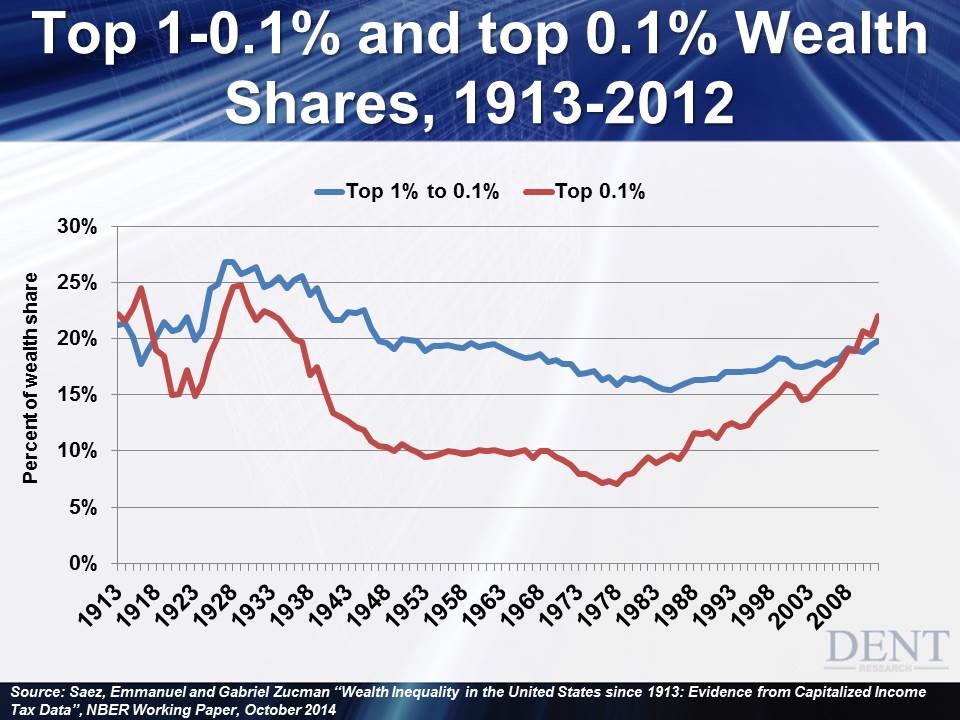One of the clear historic signs of debt and of financial bubbles is that the rich get richer… at least until the bubbles finally burst.
Janet Yellen recently commented on concerns about rising income inequality and said that it was impeding America’s economic mobility. Ironically, it’s the very Fed and central bank policies around the world that drive and exaggerate that inequality.
The top 10% control over 90% of the wealth and financial assets in the U.S. today. The top 1% controls 42% and the top 0.1% an astounding 22%.
So who gains the most when you have a weak recovery generated largely by monetary injections and zero interest rate?
It’s the rich, and even more so — the ultra-rich…
Just like during Roaring 20s and Roaring 2000s, it’s a natural occurrence that the rich get richer in fall bubble seasons…
Rich Get Richer, Almost Always
Financial assets bubble and they also represent much of the new entrepreneurial class that booms unbelievably when major new technologies and companies move into the mainstream landscape on the S-Curve.
But in this bubble boom, the Federal Reserve and central banks around the world have increasingly amplified the natural bubble and haven’t stopped feeding it since the financial meltdown of 2008.
A case in point is looking back at the top of the last major debt and financial asset bubble in 1929. The top 1% controlled 52% of the wealth in the U.S. Once that bubble burst that number fell by 35% in 1942 (winter season) and ultimately to 23% in 1978 (near end of summer season).
That’s a 56% drop in relative wealth.
The free market capitalist system has its own natural dynamics and one byproduct is that it promotes the rich getting richer when major new technologies are moving into the mainstream for the first time in the fall bubble boom season. It’s at that time when the economy needs investors and entrepreneurs to take major risks and then, rewards them handsomely for that.
In the following seasons (winter, spring and summer), the rich lose their wealth little by little. The everyday worker and middle class end up reaping some of the benefits of super innovative periods like from 1914 to 1929 or 1994 to 2007.
By looking at the chart below you can see that there’s a big difference in this bubble economy, especially since 2008 when the Fed and central banks stepped in with their unprecedented stimulus.
You can see how the top 0.1% has taken most of the gains in this boom and even more since 2002. The 0.1% has taken such a great share that the top 1% pales in comparison.

Take note that in the 1923 to 1929 bubble, the 0.1% to 1% garnered a little more wealth than the elite 0.1% — 27% vs. 25%. Obviously, the 0.1% was still about eight times as rich as the 0.1% to 1%… which is still a huge divide.
But the fortunes held by both groups rose together, it was just a little faster for the top 0.1%.
Let me also point out that during the bubble from 1994 to 2012 (it would be even more extreme if this study measured it through 2014) that the top 0.1% took the lion’s shares of the increase in percentage wealth rising from 7% to 22% while the 0.1% to 1% rose from 16% to 20%.
A Revolution Is Coming
In the previous scenario, the 0.1% became 10 times richer than the 0.1% to 1.0%
The whole point here is that the top 0.1% are doing exponentially better than the top 1% who are doing even better than the top 10% — and the top 10% are collectively the prime beneficiaries of the quantitative easing (QE) policies that have launched another huge bubble in an otherwise weak economy — as they own 9% of the wealth.
This is why Homer Simpson is taking it on the chin and seeing little or no recovery and those high on the wealth totem pole are doing better than ever.
History shows us why such vast extremes in wealth and income inequality are simply not sustainable. As I’ve written before, a revolution will come when the poor band together and rise up against the wealthy.
“Income inequality and special interests have created such an extreme situation today that everyday people will begin to revolt in developed countries. It won’t only be those in the dictator-driven economies of the emerging world trying to make themselves heard and forcing democracy for the first time.”
A reminder — during the French Revolution of 1789, royalty was sent out to the guillotines.
Don’t go off the deep end with worry because I see this extreme inequality changing in the decades ahead. Keep in mind that in the bubble of 1929, the top 1% dropped from a peak of holding 52% of the wealth to a bleak bottom when they held only 23% in 1978. That’s a massive 56% decline!
But it was the top 0.1% who took the greatest blow to their wealth. Just imagine a drop of 72%… the peak in 1929 was at 25% but by 1978, it had fallen to a paltry 7%.
The top 0.1% to 1% experienced an overall drop of 41% from their peak at 27% in 1929 to 16%.
What about that broad 90% of people at the bottom? They rose from 15% to 33% in that time period and it climbed to 36% in 1985 before falling again.
Here’s my message to you — the wealthier you are, the more you have to lose when this massive Fed-generated bubble bursts.
Don’t be complacent and get as liquid as you can, sooner rather than later… and please — don’t even entertain thoughts like “the most prime real estate in places like New York, Miami, San Francisco, Vancouver, Sydney or even London… can’t go down.”
History is very clear on that point and it has shown us that such places fall the hardest and take a long time to come back.
